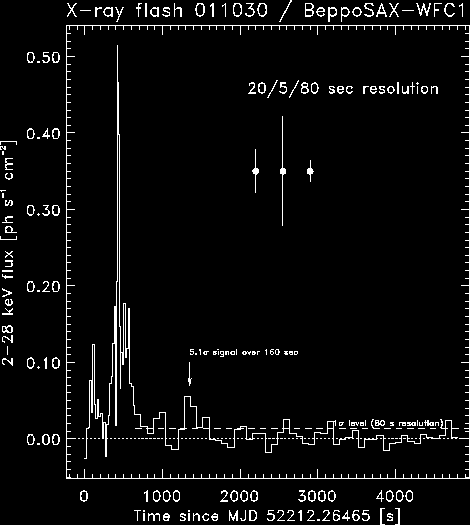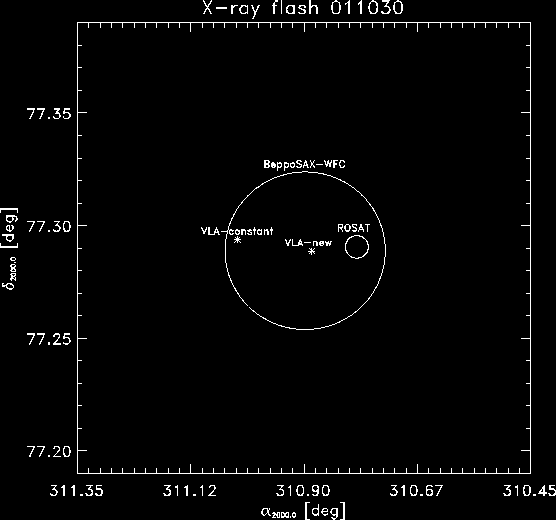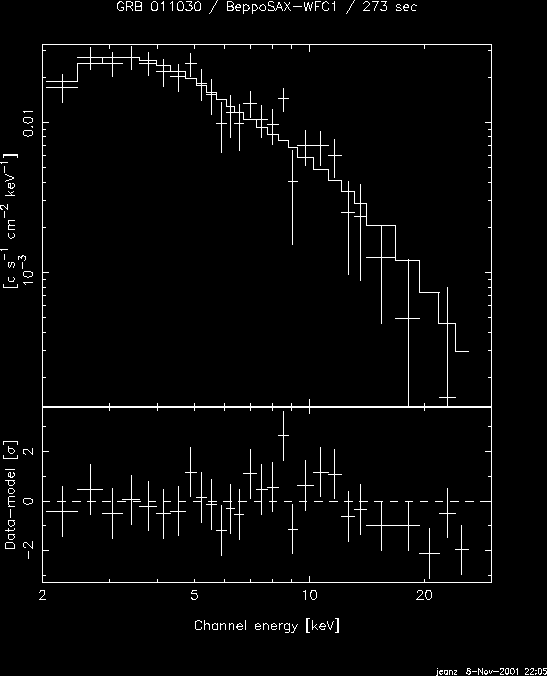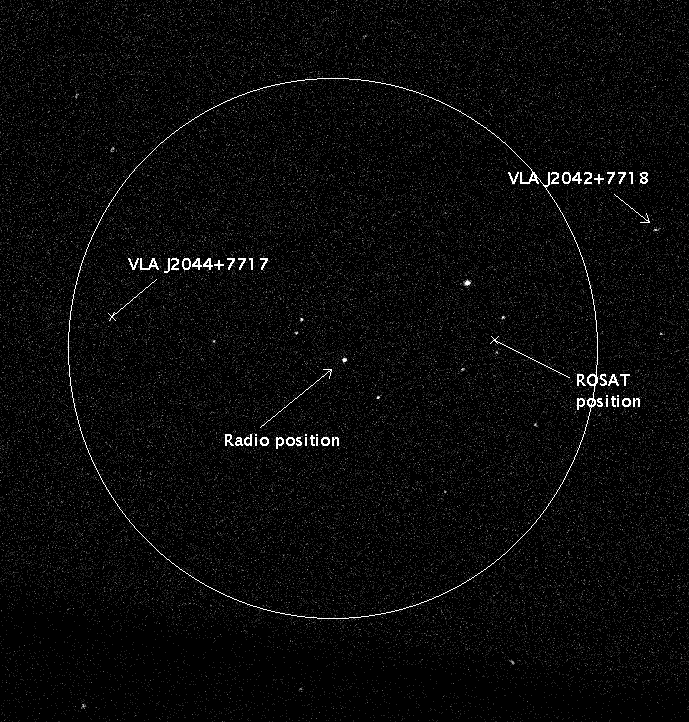
The X-ray flash of October 30, 2001
On October 30, 2001, at 6:23 Universal Time, one of the two Wide Field Cameras
(WFCs) on BeppoSAX detected a
peculiar transient X-ray signal. Its duration was measured at about 1400 sec,
and no simultaneous signal was detected in the Gamma-Ray Burst Monitor on the
same platform or any other currently active gamma-ray detector. Thus, this is
not a gamma-ray burst. Furthermore, its spectrum is inconsistent with it
being an X-ray burst which are explained as thermonuclear flashes on the
surface of neutron stars in our galaxy. This is the first flash, out of a
series of more than 10 detected with WFC since 1996
(see Heise et al.),
for which a a good
candidate counterpart has been found outside the X/gamma-ray band, namely in
the radio (Taylor et al. 2001, GCN 1136). Thus far, no optical counterpart
has been detected above upper limits of roughly magnitude 22 to 23 in the
R through Z-band. A Chandra X-ray observation taken 10 days after the
flash reveals a relatively bright X-ray source near the new radio source
(Harrison et al., GCN 1143). The suggestion is strong that this source is
brighter than the brightest gamma-ray burst at the same epoch. Another
Chandra observation was carried out on November 29, to search for decay
as typically expected from the afterglow of an explosive event.
The failure to associate X-ray flashes with any known phenomenon, their
isotropy on the sky, and the failure to find optical counterparts, suggests
that they are an exhibition of a hitherto unexplained processes that are
possibly at the edge of the universe, much further away than gamma-ray
bursts. The hope is that with the October flash (part of) the mystery will be
unveiled.
Follow a few details from X-ray observations on the October flash (WFC and
Chandra).

WFC light curve, employing consequetively 3 different time resolutions
of 20, 5 and 80 sec. The start of the light curve marks the start of
the observation.

This is a map of all interesting detections in the field. The ROSAT
source (full name 1RXS J204310.8+771726) was detected in the all-sky survey
and is conservatively assumed to have an error circle of 20 arcsec. The
constant VLA source is VLA J2044+7717 (Taylor et al. 2001, GCN 1122), the
new VLA source is at R.A.=20:43:32.3, Dec.=+77:17:18.9 (Taylor et al. 2001,
GCN 1136).

WFC spectrum of the brightest 273 s of the flash. The crosses refer to
the data and the historgram to the best fit, a power law with a photon
index of -1.9 +/- 0.1

Image of 47.8 ksec Chandra ACIS-S X-ray observation taken on Nov. 9, 2001
(GCN 1143). The image is zoomed in on the central 5 by 5 arcmin of the S3
chip. Eleven X-ray
sources are contained in the drawn WFC error circle. One of them, the one but
brightest with 330 photons, coincides with the transient radio source (GCN
1136). Another source is 5.6 arcsec from the position of a ROSAT source
(1RXS J204310.8+771726; see GCN 1123). Outside the WFC error box one source
coincides with the radio source VLA J2042+7718 (GCN 1122). It is noted that
the other VLA source inside the error box, VLA J2044+7717, is not detected.
Observations of this flash have been reported in GCN Circulars
1118,
1119 (Gandolfi et al., BeppoSAX alert messages),
1120 (Mohan et al.; R-band),
1121 (Pooley; 15 GHz),
1122 (Taylor et al.; 8.47 Hz),
1123 (In 't Zand et al.; prompt X-ray),
1124 (Rol et al.; 4.8 GHz obs),
1126 (Hammell et al.; K-Band),
1127 (Halpern et al.; I-band),
1136 (Taylor et al., 8.47 GHz),
1137 (Bloom et al.; R-Band),
1138 (Heise et al.; prompt X-ray),
1139 (Halpern et al.; I-band),
1140 (Rhoads et al., R-band),
1141 (Brown et al.; Z-band)
1142 (Klose et al.; K-band)
1143 (Harrison et al.; X-ray follow up)
1144 (Hudec et al.; optical)
1145 (Mannucci et al.; J and K-band)
1146 (Antonelli et al.; K-band)
Jean in 't Zand, SRON, December 7, 2001





